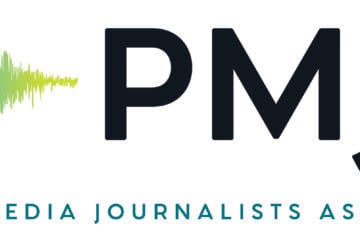To survive, pubmedia must embrace personality, co-ownership and connection — before it’s too late

Mike Janssen, using DALL-E 3
A revised version of this commentary first appeared on the author’s LinkedIn page.
Public radio has reached a breaking point, and the old ways of doing business are no longer viable. To thrive in a world dominated by personality-driven media and on-demand content, public radio must make bold, transformative changes. It’s no longer about what’s delivering the news — it’s about who’s delivering it, whether the audience connects with them, and whether the audience feels like part of something bigger. Public media needs to embrace this reality, reinvent itself and move toward a future where the creators, not the institutions, lead the charge.
The personality revolution: Public media’s missed opportunity
The success of the creator economy has made one thing clear: Audiences are loyal to people, not brands. Trust and connection are now personal. Public radio, clinging to its institutional identity, has failed to adapt to this fundamental shift. Meanwhile, creators on platforms like Patreon, Substack and YouTube have built massive followings by being authentic, relatable and directly engaged with their audiences.
- Trust is personal. People trust individuals, not institutions. A public radio host, journalist or podcaster with authenticity and relatability can build stronger bonds with audiences than a legacy brand ever could. Look at the resonance of figures like Terry Gross or Ira Glass. Their names carry far more weight than the stations behind them.
- Connection over content. Information is everywhere; connection is rare. Public radio’s content is high-quality but often lacks the personal touch that makes audiences stick around. Audiences want to feel a bond with the messenger, not just passively consume their message.
- Personality-driven media wins. People turn to personalities who interpret the news, provide context and make them feel part of a shared experience. This is why platforms like The Daily, Code Switch and independent podcasts succeed — they pair great content with strong voices.
The old gatekeeper model is dead
For decades, public radio (and legacy media in general) has operated with a top-down, gatekeeper mentality. A select few decide what content is made, how it’s delivered and who gets to create it. That model no longer works. Audiences don’t want content dictated by institutional gatekeepers; they want creators who feel authentic, approachable and in touch with their lives.
The solution? Share the power. Public media must radically rethink its structure, empowering creators to become part owners and investors in the shared success of the organization.
Making creators stakeholders
Public radio’s survival depends on attracting and retaining a new generation of media creators who have the skills, ambition and relatability to thrive in today’s personality-driven media landscape. To do this, public radio must offer more than a paycheck — it must offer creators a meaningful stake in the organization’s future.
- Empower creators as co-owners. Move beyond the outdated “employee” model. Give creators equity or revenue-sharing agreements that tie their success to the success of the station. This model aligns incentives: Creators who feel ownership over their work will be more invested in building audiences, innovating formats and strengthening public media as a whole.
- Invest in their success. Provide creators with the tools, training and resources they need to grow their audiences and develop their personal brands. This includes access to professional development, marketing support and platforms that amplify their reach. For example, imagine a public media talent incubator similar to what led to discovering Glynn Washington and Al Letson that trains the next generation of podcast hosts, journalists and multimedia storytellers.
- Break down institutional barriers. Public radio must shed its hierarchical structure and foster a culture of collaboration. Give creators the freedom to experiment with new formats and platforms without needing endless layers of approval. Example: Let hosts and journalists run personal newsletters or social media accounts under their own names, building direct connections with audiences while still contributing to the station’s overall success.
- Attract diverse, entrepreneurial talent. By giving creators real ownership, public radio can attract entrepreneurial talent who might otherwise gravitate toward independent platforms. These creators bring fresh energy, new ideas and diverse perspectives that public radio desperately needs.
The new public media model: personality + ownership + connection
To reinvent itself, public radio must move beyond outdated institutional thinking and adopt the best practices of the creator economy. Here’s what this new model looks like:
- Personality first, institution second. The audience doesn’t care about the station ID — they care about the voice they connect with. Elevate individual talent, make them the stars and let them shine.
- Shared success. Creators should have a direct stake in their work’s success. Revenue-sharing, equity or bonuses tied to performance will incentivize creators to innovate and build loyalty with audiences.
- Audience connection as the core mission. The days of passive consumption are over. Public media must build real, two-way relationships with audiences through direct engagement, personalized content and community-building initiatives.
- Digital-first, platform-agnostic content. Public media must stop thinking of itself as “radio.” It needs to embrace podcasts, newsletters, video, social media and whatever comes next. Meet audiences where they already are.
- Collaboration and consolidation. Individual stations are too small to compete in today’s media landscape. Consolidate resources, invest in shared technology and build regional and national networks that amplify talent and scale success.
The urgency: Act now or fade away
Public radio has a window of only a few years to reinvent itself. Without immediate action, it risks following the same path as local newspapers — irrelevance, layoffs and decline. Here’s the road map:
- Take stock of resources. Conduct a thorough audit of what’s working and what’s not. Identify your strongest talent, programs and platforms, and double down on them.
- Make the next generation co-owners. Recruit and retain new talent by offering real stakes in the organization’s success. Let them be creators, owners and investors, not just employees.
- Invest in people, not institutions, and not buildings. The future of public radio lies in its people. Build up your creators, give them freedom and resources, and let them take the lead in forging direct relationships with audiences.
- Experiment boldly. Try new formats, platforms and revenue models without fear of failure. Iterate quickly and scale what works.
The future of public radio is personal, collaborative and shared
Public radio’s success will not come from clinging to its legacy or doubling down on old models. It will come from empowering the next generation of creators to lead the way — by giving them ownership, amplifying their voices and prioritizing the connections they forge with audiences. The days of the legacy gatekeeper are over. The future belongs to those who embrace collaboration, personality and shared success.
If public radio can make this pivot, it will not only survive — it will thrive as the leading force in community-driven, personality-first media. But the time to act is now. The window is closing. Bold action today will define public radio’s tomorrow.
Andrew Ramsammy is currently interim president of Vermont College of Fine Arts and was previously chief impact officer for the Local Media Association.






+1 for “The urgency: Act now or fade away”
Generally great stuff – my main difference -its not “Digital First” -that’s outdated, its “Audience First” – stop thinking of the delivery first – think of the audience, it will get you to where they are faster. I would love to get to a shared revenue model – most public stations are losing money – so that has to get fixed first and it is non-profit, so just need to be careful- but the point of thinking new is not lost.